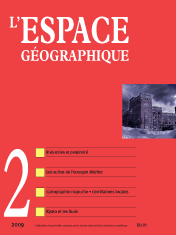

Manufacturing districts and the identity of firms (4 fig., 1 photo, 1 tabl.)
This paper looks at the identity of manufacturing firms in the eyeglass manufacturing district of Morez. The spatial organisation of the eyeglass industry is changing rapidly in an environment of globalisation and foreign competition. These changes are giving rise to a process of construction-reconstruction of the firms’ identities on manufacturing issues that are taking on a symbolic dimension. The spatial and industrial strategies of firms are interlinked with their identities. These transformations are leading to a differentiation of firms’ identities within the district’s shared culture.
keywords: EYEGLASS INDUSTRY, IDENTITY, MANUFACTURING CULTURE, MANUFACTURING DISTRICT
Implications of supplier proximity in the French automotive industry (3 encadrés, 3 fig.)
Carmakers increasingly source globally, but when close coordination between workers is required, it is preferable for plants to be geographically close to each other. French carmakers have encouraged their suppliers to set up plants near their assembly lines for just-in-time delivery. This trend has taken on a new dimension with the recent creation of supplier parks inside carmakers’ assembly plants. Daily contact increases the pressure on suppliers’ employees, and the relationship between the client and the supplier is more akin to subcontracting than partnership.
keywords: AUTOMOTIVE, GLOBAL SOURCING, PROXIMITY, SUBCONTRACTING, SUPPLIER PARKS
Almost three years after Hurricane Katrina hit New Orleans, recovery is both incomplete and inconsistent. This paper is both a methodological reflection on relevant indicators and scales of observation for an analysis of recovery, and an initial summary of the dynamics of recovery. It discusses in particular how the “regime of uncertainty” created by the city and federal authorities’ plans and actions is hampering the recovery process. These “top-down” effects are then compared with “bottom-up” dynamics the independent, participatory resilience of local communities, who have created their own “recovery capital”.
keywords: HURRICANE KATRINA, NATURAL DISASTER, RECOVERY CAPITAL, RESILIENCE, URBAN FRAGMENTATION
The Kyoto Protocol, the North-South divide and the challenge of sustainable development (7 fig., 4 tabl.)
The Kyoto Protocol set the target of a reduction of at least 5% in greenhouse gas emissions generated by human activities by 2008- 2012 against a 1990 baseline. This reduction is required of developed countries only. The divide with other countries thus ratified is analysed in this paper using the most recent economic and environmental data. Each country’s Human Development Index is compared with its carbon footprint to address the double requirement of sustainable development: an ecological footprint of no more than 2.1 hga per person and an HDI of at least 0.800. This means that socioeconomic development must be achieved simultaneously with environmental protection by involving both developed and developing countries.
keywords: ECOLOGICAL FOOTPRINT, GREENHOUSE GAS EMISSIONS, HUMAN DEVELOPMENT INDEX, KYOTO PROTOCOL, SUSTAINABLE DEVELOPMENT
Interpolation by local regression applied to precipitation in France (7 fig., 4 tabl.)
Two interpolation methods are presented. The global one operates by means of a regression processing applied on the complete data set and the local one consists in a regression processing applied individually to many local sets made of recording stations each. The procedure is applied to the amount of precipitation in France. The local interpolation provides better results than the global one. The contradictory effects between crest lines and plains close below which are drier are well shown by the local model. This one allows other indicators from the regressions which interpretation provides keys for understanding how the climate distribution is differentiated by environmental factors.
keywords: FRANCE, INTERPOLATION, PRECIPITATION
Indigenous Mapping. Elements for a critical analysis (4 fig., 3 photos)
Studies of indigenous mapping represent an under-developed academic field in French-language geography. This article reviews recent developments on the subject in English-language literature. It gives also an account of the main theoretical debates, which consider the use of Western mapping by indigenous peoples either as an instrument of empowerment and decolonisation or as a source of cultural assimilation. These aspects are examined in the light of an experiment in indigenous mapping performed by the Mapuche people in Chile.
keywords: DECOLONISATION, INDIGENOUS MAPPING, TERRITORY, MAPUCHE
Book reviews
In this issue of l’Espace géographique, you will find critical reviews of the following books
ANTEBY-YEMINI L., BERTHOMIÈRE W., SHEFFER G. (dir.) (2005). Les Diasporas. 2000 ans d'histoire. Rennes: Presses universitaires de Rennes, 497 p. (Christian Girault, CNRS Paris)
BROSSARD T., WIEBER J.-C. (dir.) (2008). Paysage et information géographique. Paris: Hermès, Lavoisier, 414 p. (Joël CHARRE, université d'Avignon)
BRUNEAU M. (dir.) (2005). Diasporas et espaces transnationaux. Paris: Anthropos, coll. «Villes-géographie», 249 p. (Christian Girault, CNRS Paris)
CHIVALLON C. (2004). La Diaspora noire des Amériques. Expériences et théories à partir de la Caraïbe. Paris: CNRS Éditions, coll. «Espaces et milieux», 258 p. (Christian Girault, CNRS Paris)
ROCARD M. (2008). Oui à la Turquie. Paris: Hachette Littératures, coll. «Tapage», 130 p. (Benoît MONTABONE, université européenne de Bretagne, Rennes)
L’espace géographique 1/09![]()
![]() L’espace géographique 3/09
L’espace géographique 3/09
For subscribe or buy this issue: BELIN
![]() L’Espace géographique: contents
L’Espace géographique: contents
Last modified: May 29, 2009